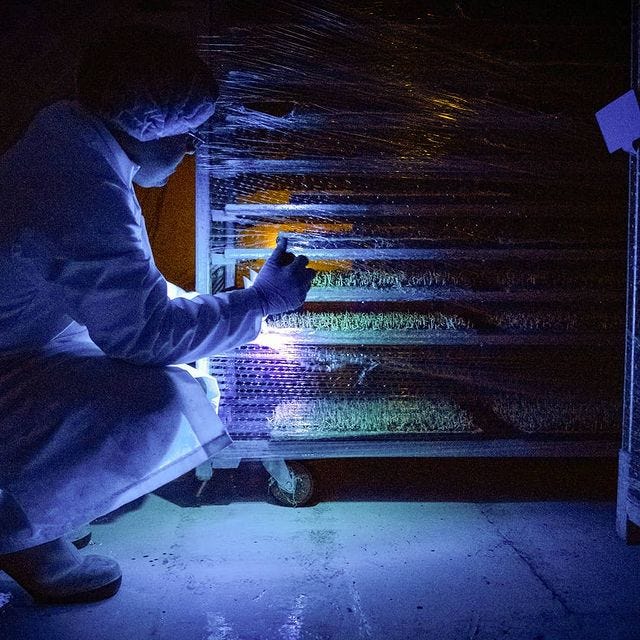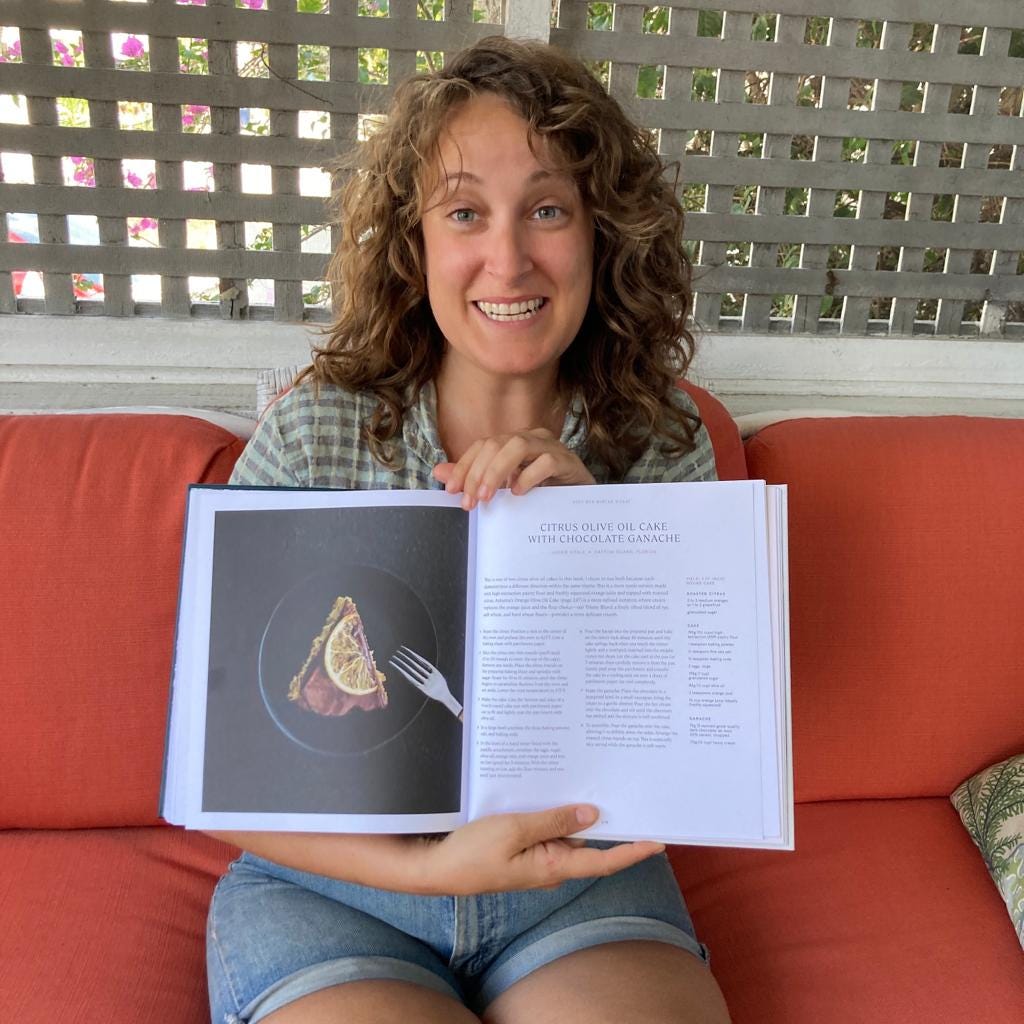We’re sending this out a few days late because we wanted to be able to include these hot-off-the-press in-person workshops. Check out the details below and come and cook with Jackie in her cute backyard!
If someone shared this newsletter with you, subscribe here:
My friend Matt H., who I trust for all things techie, recently sent me this Popular Mechanics article about a futuristic farm in London. Well...underneath London.
Growing Underground produces specialty greens for high-end restaurants and supermarkets around the city, in a repurposed bomb shelter 108 feet below Clapham High Street. The operation is ultra high-tech and resource efficient. Nothing from the outside world gets in, including sunlight. Instead, they make use of LED lights to create the equivalent of 18 hours a day of sunlight, meaning the crops grow super fast. Inside this compound, there’s no need for any of the -cides (pesti, herbi, or fungi). The setting is extremely cool in a space age sort of way, but it also gives me the willies. Folks in spacesuits growing perfect vegetables in hermetically sealed chambers under the earth? Is that really “the future of farming”, as Popular Mechanics posits?
One thing is certain: the future of farming cannot remain the large scale, resource intensive industrial agriculture that we practice in the United States. We don’t have the land or the fossil fuels needed to keep that ship afloat.
Perhaps future farms will be ultra high tech, like they’re banking on in the Netherlands, and at operations like Growing Underground. Or will agriculture return to its low-tech roots, relying on small plots, closed-loop systems, and simple “appropriate technologies” (tools made from local material or repurposed from whatever is lying around)? That’s what they’re preaching at Echo Farms, the “teach a man to fish” hunger nonprofit in Southwest Florida.
Reading about Growing Underground’s operation made me think about what the future of farming might actually be. I thought it would be fun to share a few possibilities with you.
The Full Diet CSA (Community Supported Agriculture): Essex Farms, Essex, N.Y.
Kristin Kimball immortalized Essex Farms in her impossible-to-put-down-memoir, The Dirty Life. Full diet CSAs attempt to produce all of the calories their customers need: veggies, protein, carbs, sweeteners, etc. It’s a closed-loop system, because the waste from one product feeds the production of another (cow poop becomes veggie fertilizer; veggie scraps feed chickens; offseason cover crops add nutrients to the soil to help the main season crops can flourish).
The Front Yard Garden: Fleet Farming, Orlando, Fla.
Fleet Farming is on a mission to transform Orlando’s front yards into microfarms. Homeowners can offer up a portion of their yard to the nonprofit. A fleet of bicycle-powered volunteer gardeners will transform the plot into productive garden beds and maintain it throughout the growing season. The homeowners keep half of the produce grown on their site, with the rest sold at local farmers markets.
The Permaculture Farm: Atitlan Organics, Tzununa, Guatemala
Like many permaculture farms, Atitlan Organics looks more like a wild forest than tidy rows of garden beds. That’s because permaculture attempts to learn from the wisdom of nature by mimicking its patterns and connections. If two plants appear together in the wild, a permaculturist will deduce a symbiotic relationship, and plant them together. Other permaculture principles include taking only what you need and earth stewardship. Besides teaching about permaculture, this farming team produces veggies, tropical fruits, eggs, chicken, and pork.
Indigenous Land Stewardship: Ramona Farms, Sacaton, Ariz. (Akimel O’Odham land)
Ramona and Terry Button have been growing a variety of heirloom crops for over 40 years. Crops like the tepary bean and pima corn were vital foods for the native Akimel O’Odham people of the region. But those crops were on the brink of extinction before Ramona Farms brought them back into cultivation. Ramona Farms uses indigenous land stewardship principles that maintain balance and promote biodiversity. There is so much to learn from indigenous cultures in regards to land stewardship, habitat protection, and sustainable food production.
love,
Jackie
Give us a follow: We’re five followers away from 2,000 on Sunshine + Microbes Instagram!
Recommended Reads
Sunshine + Microbe recipes featured in a new book on flour!
When Jennifer Lapidus, the miller at Carolina Ground told me she was writing a book, I was thrilled about all the forthcoming recipes using stone ground flour. When she asked to include a profile of me and some of my recipes, I was a bit flabbergasted! I am a self-taught baker and still a newbie — and this book would feature some of my bread heroes.
Jennifer has been working on this beautiful book for several years now. It is part memoir, part homage to Southern baking culture, and part recipe book. “Southern Ground” is officially out tomorrow. I’ve had the opportunity to tear through a copy, and it is divine. Every recipe looks fabulous, it includes the stories of many inspiring Southern bakers, plus lots of cool grain science and history to nerd out on.
This is a must-have cookbook for bakers (and not just because it involves me). You can order it right from the author herself!
-Jackie
🔆🚽The Climate Crisis is Worse Than You Can Imagine. Here’s What Happens if You Try. | ProPublica
Earth Day just passed, so let’s find out what happens if you worry about the future of the Earth every single day of your whole dang life. Peter Kalmus, a climate scientist who has previously worked at NASA, spends his time striving and begging people to pay attention to the climate crisis. For the sake of his kids, will someone please listen?
Although honestly, his obsession is starting to drive his two kids a little crazy too.
The story is darkly funny. Kalmus, 46, goes dumpster diving. In his underwear, he fends off raccoons from his chicken coop. He laments that his wife Sharon and two sons stopped using the outdoor composting toilet. (“The other three family members are not interested in contributing at all.”)
But it’s also a beautifully told piece of writing by Liz Weil that takes an intimate look at Peter and Sharon just trying to make a relationship work in catastrophic times — with a partner who cannot turn away from a reality that most of us choose to ignore for the sake of our own sanity.
🥕🍅🥒How a British Retiree Became the Twitter King of ‘Big Veg’ Gardening | Eater
Gerald Stratford, a 72-year-old former fisherman in the U.K., has become a viral star in his retirement as a exceptionalgardener of “big veg.”
He has grown 80-pound zucchinis, 150-pound pumpkins and 9-pound cucumbers in his community garden (or “allotment” as they say in British speak). He’s even cultivated tromboncinos — a type of squash — that reached over 40 feet long. The photos of an amiable-looking Stratford holding his giant veggies has turned him into a much-needed social media antidote to the pandemic doldrums. (It’s also earned him a book deal and some images in a Gucci ad).
All those vegetables he either donates to family and friends or to charities. Sometimes he and his wife turn them into jams, chutneys, pickles, and preserves or slow-cooked roasted veggie meals. But one of Gerald’s favorite treats is quite simple: “a fresh, room-temperature tomato, with Himalayan pink salt sprinkled on it.”
🍹Fifty Years Ago a Texan Changed Happy Hour Forever | Texas Monthly
This is a delightful story on the humble origins of the frozen margarita machine, an invention that changed cocktail hour everywhere.
The man behind the machine is Mariano Martinez, who opened his own Mexican restaurant in Texas in 1971. Earlier that year, the state legalized selling liquor by the drink in restaurants. When Martinez’s place first opened, his barkeepers found themselves overwhelmed trying to satisfy icy drink orders, including a signature frozen margarita. Martinez began tinkering with an apparatus similar to what he found in 7-Eleven stores selling Slurpees. He experimented “with different amounts of tequila, orange liqueur, and fresh lime juice.” The final product revolutionized happy hours everywhere.
Martinez, who dropped out of high school in 10th grade after enduring loads of racist bullying, still helps run five Mexican restaurants that he helped open in Texas. And his first frozen margarita machine can be found at the Smithsonian Institution’s National Museum of American History, in Washington, D.C., on permanent display near Julia Child’s kitchen.
Infused Vinegar
Over the past few months I’ve grown a little collection of infused vinegars on my kitchen shelf. This is a simple preservation method that builds flavor, adding depth and a bit of fun to whatever you’re cooking. Think thyme-infused balsamic drizzled over roasted strawberries and vanilla ice cream or a fresh tomato salsa livened up with garlic and cumin-infused apple cider vinegar. Finish a homemade pizza with a chili-infused olive oil.1
Creating an infused vinegar is also a great way to draw flavor from scraps like garlic and onion skins and herb stems.
The acidity in the vinegar makes this preservation process quite safe, particularly when using clean jars and tools. But for the extra cautious, you can lightly heat the vinegar to just below boiling (190°F to 195°F). Find more tips in this infused-vinegar deep dive from University of Georgia Extension Service.
ingredients
vinegar of choice
flavorings of choice (garlic cloves or peels, herbs [the whole thing or just the stems], spices, dried chilis, citrus peels, etc)
step-by-step
Place flavoring in a clean jar.
Fill jar with vinegar and seal tightly.
Allow the vinegar to infuse at room temperature for about a month.
Strain out flavorings and store infused vinegar in an airtight container. The conservative food safety guidelines say it will keep for 2-3 months at room temperature and 6-8 months in the fridge. I can personally attest that I have stored and used infused vinegar at room temperature without trouble for much, much longer periods than 3 months.
Upcoming classes and other food events happening virtually or in South Florida. Email us with calendar submissions!
Food Memories of Asia | UF | May 1 at 1 p.m. | Zoom
Focaccia Workshop with Jackie | May 6 at 6 p.m. | Stuart, Fla. | $45
Sauerkraut + Kimchi Workshop with Jackie | May 12 at 6 p.m. | Stuart, Fla. | $45
Pizza Party with Jackie | May 21 at 6 p.m. | Stuart, Fla. | $55
Masculinity… and reality.
Talk to Us
Send in your comments, mailbag questions, recipe mishaps, or cooking tips: sunshineandmicrobes@gmail.com. Also do us a favor and follow us on Facebook and Instagram. Visit our website and cook yourself something nice.
If you enjoyed this email, please share it with others. If someone forwarded this to you, click the button to sign up:
----------------------------------------------------------------------------------------
Sunshine + Microbes team
Jackie Vitale is a cook and kitchen educator based in Stuart, Fla . She runs Otto’s Bread Club and is co-founder of the Florida Ferment Fest. Her newsletter explores the intersection of food, culture, environment and community.
Matt Levin is a communications specialist at the ACLU of Texas. He edits Sunshine + Microbes and contributes other scraps to each issue.
I use this same process to make an all-purpose cleaner — by throwing squeezed lemons and limes into a big jar that I continuously top off with apple cider vinegar.















